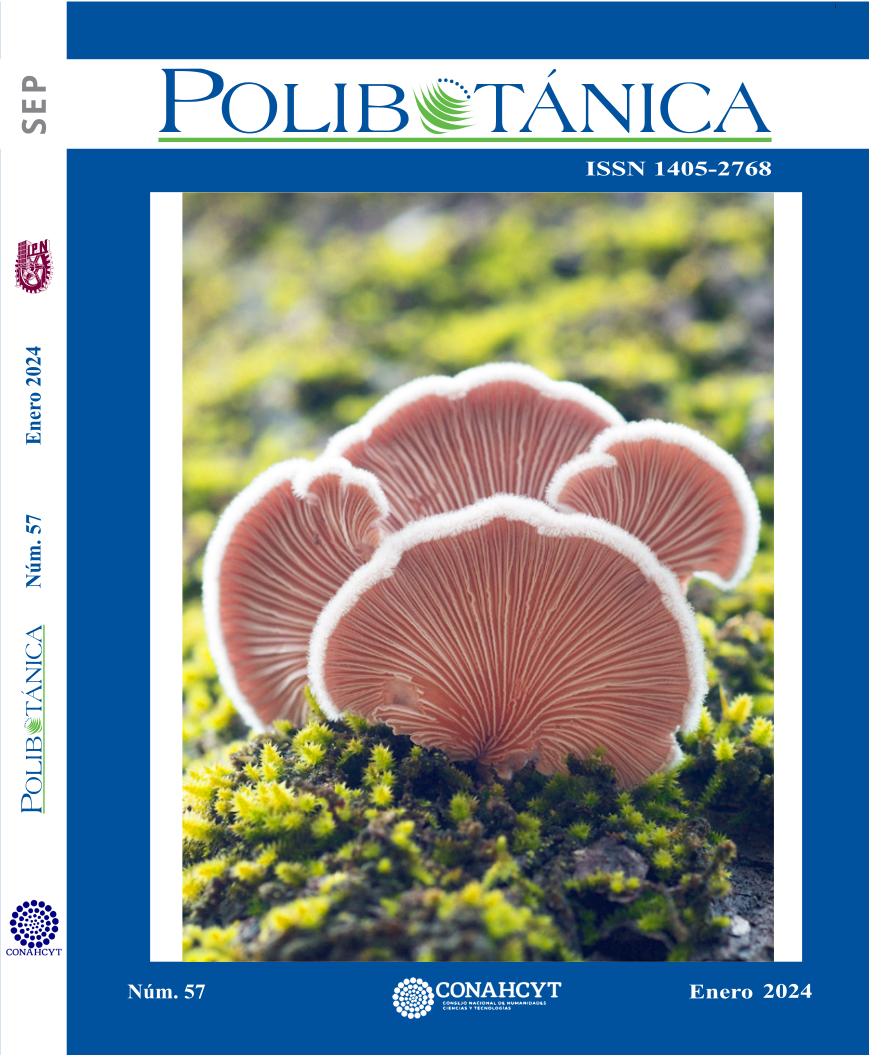Mechanical properties and chemical composition of native tree roots in a temperate forest in, Durango, Mexico
DOI:
https://doi.org/10.18387/polibotanica.57.6Keywords:
soil, fixation, reinforcement, forest species, bioengineeringAbstract
In Mexico, many highways are laid out on a rugged topography, making them vulnerable to landslides, causing social, economic, and environmental damage. One of the best practices that minimize the failures in the slopes is the establishment of a vegetal cover, where the roots play an important role in the stability of the slopes. The objective of this research was to evaluate the mechanical and chemical characteristics of the forest species roots exposed in the cuts of slopes of the road section that connects the urban area with the rural area of the municipality of Pueblo Nuevo. Thirty root samples per species of three diameter categories (0.1-3.0 mm, 3.1-6.0 mm and 6.1-10 mm) were collected. The mechanical properties (Fmax, Ts and Eroot) were analyzed with an Instron SATEC universal machine at a constant speed of 10 mm/min. The amount of cellulose, lignin and hemicellulose was determined by the Van-Soest method. The results showed significant differences between species for all the properties analyzed. Particularly Juniperus deppeana presented higher values of Fmax, Ts and Eroot of 402.80 N, 34.06 N mm2, 1283.45N mm2, as well as the contents of cellulose (40.29%), hemicellulose (12.57%) and lignin (37.63%), which that potentiates its use in soil bioengineering. However, the complement of the species also contributes to a different degree to the stabilization of slopes and slopes, so this study may be key to facilitate decision-making for the restoration of the ecosystem and road slopes.
References
Chen, L.-K., Chen, S.-C., & Ke, M.-C. (2015). Investigation of the Freeway No. 3 Landslide in Taiwan. En Engineering Geology for Society and Territory - Volume 2 (pp. 2093–2096). Springer International Publishing. https://doi.org/10.1007/978-3-319-09057-3_374
Downs, M. (2013). Manual de Bioingeniería (Cruz Roja Hondureña y Cruz Roja Suiza, Ed.; 1a ed).
Fernández-Villarreal, B., Zavala-González, R., Cantú-Silva, I., & González-Rodríguez, H. (2022). Composición química y morfología de raíces de cinco especies arbustivas nativas y su influencia en la fijación del suelo. Botanical Sciences, 100(1), 28–41. https://doi.org/10.17129/botsci.2777
Galindo, S. J. A., & Alcántara, A. I. (2015). Inestabilidad de laderas e infraestructura vial: análisis de susceptibilidad en la Sierra Nororiental de Puebla, México. Investigaciones Geográficas, 88. https://doi.org/10.14350/rig.43790
García, E. (2004). Modifications to the Köppen climate classification system (6ed ed.).
Garnica, P. A., & Pérez C. G. (2012). Metodología para la Gestión de Cortes Carreteros (Instituto Mexicano del Transporte, Ed.; 370a ed., Vol. 1).
Genet, M., Li, M., Luo, T., Fourcaud, T., Clément-Vidal, A., & Stokes, A. (2010). Linking carbon supply to root cell-wall chemistry and mechanics at high altitudes in Abies georgei. Annals of Botany, 107(2), 311–320. https://doi.org/10.1093/aob/mcq237
Genet, M., Stokes, A., Salin, F., Mickovski, S. B., Fourcaud, T., Dumail, J.-F., & van Beek, R. (2005). The Influence of Cellulose Content on Tensile Strength in Tree Roots. Plant and Soil, 278(1–2), 1–9. https://doi.org/10.1007/s11104-005-8768-6
Grajales, S. F., Vallarino, R., Mejía, G., & Centella, D. (2021). Bioingeniería de taludes: evaluación del uso de árboles y arbustos como posible mecanismo para incrementar el factor de seguridad. Revista de Iniciación Científica, 7(2), 26–38. https://doi.org/10.33412/rev-ric.v7.2.3336
Gray, D. H., & Sotir, R. B. (1996). Biotechnical and Soil Bioengineering Slope Stabilization: A practical Guide for Erosion Control. (John Wiley & Sons, Ed.).
Hales, T. C., Ford, C. R., Hwang, T., Vose, J. M., & Band, L. E. (2009). Topographic and ecologic controls on root reinforcement. Journal of Geophysical Research, 114(F3), F03013. https://doi.org/10.1029/2008JF001168
Jung-Tai, L., Sung-Ming, T., & Ming-Jen, L. (2017). Uprooting resistance of two tropical tree species for sand dune stabilization. African Journal of Agricultural Research, 12(45), 3214–3220. https://doi.org/10.5897/AJAR2017.12715
Khalilnejad, A., Faisal Hj. Ali, & Osman, N. (2011). Contribution of the Root to Slope Stability. Geotechnical and Geological Engineering, 30(2), 277–288. https://doi.org/10.1007/s10706-011-9446-5
Li, S.-C., Sun, H.-L., Yang, Z.-R., Xiong, W.-L., & Cui, B.-S. (2007). Root anchorage of Vitex negundo L. on rocky slopes under different weathering degrees. Ecological Engineering, 30(1), 27–33. https://doi.org/10.1016/j.ecoleng.2006.11.008
Maceda, A., Soto-Hernández, M., Peña-Valdivia, C. B., Trejo, C., & Terrazas, T. (2022). Lignina: composición, síntesis y evolución. Madera y Bosques, 27(2), 1–16. https://doi.org/10.21829/myb.2021.2722137
Martínez, A., Dejong, J., Akin, I., Aleali, A., Arson, C., Atkinson, J., Bandini, P., Baser, T., Borela, R., Boulanger, R., Burrall, M., Chen, Y., Collins, C., Cortes, D., Dai, S., DeJong, T., Del Dottore, E., Dorgan, K., Fragaszy, R., … Zheng, J. (2022). Bio-inspired geotechnical engineering: principles, current work, opportunities and challenges. Géotechnique, 72(8), 687–705. https://doi.org/10.1680/jgeot.20.P.170
Melese, D. T., Senadheera S., & Legas A. T. (2021). Effect of Diameter, Root Moisture Content, Gauge Length and Loading Rate on Tensile Strength of Plant Roots and Their Contribution to Slope Stability. Lowland Technology International Journal, 22, 164–173.
Mora–Ortiz, R.S. y Rojas–González E. (2012). Efecto de la saturación en el deslizamiento de talud en la comunidad San Juan de Grijalva, Chiapas. Ingeniería, investigación y tecnología, 13, 55–68.
Pérez, S. L. I. (2014). Seguridad estructural para construcciones en zonas inundables. Criterio diseño. Soluciones de minoración del riesgo de fallo. Universidad Politécnica de Madrid.
Sánchez-Castillo, L., Kubota, T., Cantu-Silva, I., Yañez-Diaz, M., Hasnawir, & Pequeño-Ledezma, M. (2017). Comparisons of the root mechanical properties of three native Mexican tree species for soil bioengineering practices. Botanical Sciences, 95(2), 259–269. https://doi.org/10.17129/botsci.802
Sánchez-Castillo, L., Kubota, T., Hasnawir, & Cantu-Silva, I. (2017). Influence of Root Reinforcement of Forest Species on the Slope Stability of Sierra Madre Oriental, Mexico. Journal of the Faculty of Agriculture, Kyushu University, 62(1), 177–181. https://doi.org/10.5109/1801779
Stokes, A., Douglas, G. B., Fourcaud, T., Giadrossich, F., Gillies, C., Hubble, T., Kim, J. H., Loades, K. W., Mao, Z., McIvor, I. R., Mickovski, S. B., Mitchell, S., Osman, N., Phillips, C., Poesen, J., Polster, D., Preti, F., Raymond, P., Rey, F., … Walker, L. R. (2014). Ecological mitigation of hillslope instability: ten key issues facing researchers and practitioners. Plant and Soil, 377(1–2), 1–23. https://doi.org/10.1007/s11104-014-2044-6
Valdés-Rodríguez, O. A., Alonso, Á. E. J., Martínez, A. S., & Andrade, J. T. (2020). Tension and bending tests in roots of two tropical species. Madera y Bosques, 26(2), 1–13. https://doi.org/10.21829/MYB.2020.2621716
Van-Soest, P. J., Robertson, J. B., & Lewis, B. A. (1991). Methods for Dietary Fiber, Neutral Detergent Fiber, and Nonstarch Polysaccharides in Relation to Animal Nutrition. Journal of Dairy Science, 74(10), 3583–3597. https://doi.org/10.3168/jds.S0022-0302(91)78551-2
Wang, X., Ma, C., Wang, Y., Wang, Y., Li, T., Dai, Z., & Li, M. (2020). Effect of root architecture on rainfall threshold for slope stability: variabilities in saturated hydraulic conductivity and strength of root-soil composite. Landslides, 17(8), 1965–1977. https://doi.org/10.1007/s10346-020-01422-6
Yang, Y., Chen, L., Li, N., & Zhang, Q. (2016). Effect of Root Moisture Content and Diameter on Root Tensile Properties. PLOS ONE, 11(3), e0151791. https://doi.org/10.1371/journal.pone.0151791
Zavala-González, R., Cantú-Silva, I., Sánchez-Castillo, L., González-Rodríguez, H., Kubota, T., & Hasnawir. (2019). Ten Native Tree Species for potential use in Soil Bioengineering in northeastern Mexico. Botanical Sciences, 97(3), 291–300. https://doi.org/10.17129/botsci.2131
Zhang, C.-B., Chen, L.-H., & Jiang, J. (2014). Why fine tree roots are stronger than thicker roots: The role of cellulose and lignin in relation to slope stability. Geomorphology, 206, 196–202. https://doi.org/10.1016/j.geomorph.2013.09.024
Downloads
Published
Issue
Section
License

Polibotánica by Departamento de Botánica de la Escuela Nacional de Ciencias Biológicas del Instituto Politécnico Nacional se distribuye bajo una Licencia Creative Commons Atribución-NoComercial-CompartirIgual 4.0 Internacional.




















